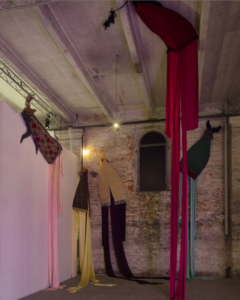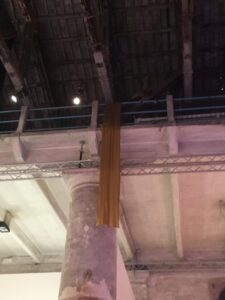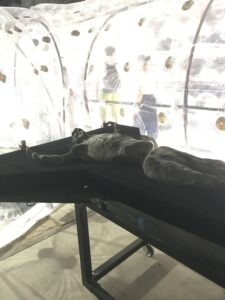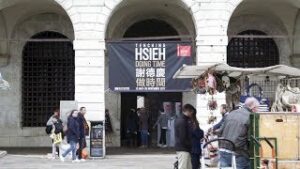Hidden World + Creepy Crawlies
There are in fact around 100 different species of arthropod — a category that includes spiders, insects, centipedes, and mites — that inhabit the average American home, according to the results of a biodiversity survey published in the journal PeerJ on Jan. 19
-Business Insider
There have been many films and novels written about hidden worlds, about the world being altered in scale for the characters. Take Arriety, for example, from the film The Borrower Arrietty: a miniature girl viewing our world as a perilous landscape of vicious bugs, leaves as floating vessels, and hides in mouse holes for refuge. It is rare that we as humans experience anything like that. Petrit Halilaj’s Do you realize there is a rainbow even if it’s night? is a subtle series of artistic forms, scattered along the rafters in the Biennale. One’s vision of the world is irrevocably changed after the truth is revealed, that the viewer is surrounded by these hulking, bug-like figures. The sculptures are made of traditional Kosovar fabrics. The space, masterfully manipulated by the artist, suddenly becomes threatened by the creatures. The animals aren’t obvious, similarly to the invisible world of creepy crawlies for us humans. The artist makes us feel small, a welcome use of physical space. The piece extends far beyond of prescribed, limited space, leaping off of its metaphorical canvas and into the space shared by other artists. There is also something to be said about the commentary of attention—audiences at the Arsenale are so wrapped up in more dazzling pieces closer to the ground that they are distracted from the climbing creatures up in the rooftops.
Natural Decay + Base Components
A notable theme at the Biennale was that of artificial constructions breaking down into more natural components. A very clear example is that of numerous brooms standing upright in a patch of long grass. A panel reveals that the broom had been made “natural” by removing certain synthetic parts of the brooms so that the seeds within them were allowed to sprout and grow. A second example is that of the “Imitation of Christ”, wherein forms, resembling atrophied human bodies, are contained so that natural mold grows upon them. Again these are man-made structures allowed to decay and fall apart. A slightly more contrived naturalization process is that of a wall of shoes, with plants and soil being allowed to grow from inside them. Given other pieces that were focused upon the environment, perhaps this is a commentary upon nature overpowering industrialization and humanity, although whether that is a good or bad thing, I don’t know. This is not a new premise, but these are beautiful ways of representing the strength of nature. Another example of this idea is present in a piece where a water droplet falls slowly onto a book, creating colors as the pages degrade.
Doing Time + Tone-Deaf Panels
Doing Time by Tehching Hsieh is a prime example of didactic choices on behalf of a curator detracting from the message, and the reception, of a performance art piece. The curator presented remarkably tone-deaf commentary from a modern standpoint. In the One Year Performance by Hsieh, he spends an entire year without shelter, marking his wonderings on maps. He marked the amount of money that he spent on food each day. The didactic describes Hsieh’s condition as “exceeding homelessness”. This is problematic because, at least as the panel presents it, the piece is attempting to mimic the lifestyle of a marginalized group while suffering none prolonged consequences. On one of Hsieh’s maps, he even writes that a friend bought him lunch. It is an insulting simulation. However, ignoring the didactic, Hsieh’s own point of view is most likely more concerned with the ideas of “freedom and constraint”, much more in line with issues of migration and border control than homelessness. The issue is that one throw-away line on a wall utterly ruined the meaning of the piece, and no amount of philosophy could salvage it for me.
In addition, the phrasing of the aim of his piece, wherein he jumps out a two story building, falls painfully flat. The writer adds at the end a comment about the idea of demonstrating gravity. This seems almost banal to me. I feel as if there were many other layers worthy of exploration into the power of pain in performance that were not further examined. There is not sufficient meditation upon the works and their merits, but rather the exhibit is a shallow time capsule of a presumably poignant performance artist.





